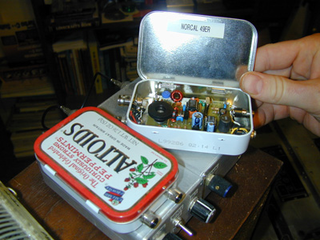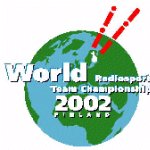Related Research Articles

Morse code is a method used in telecommunication to encode text characters as standardized sequences of two different signal durations, called dots and dashes or dits and dahs. Morse code is named after Samuel Morse, an inventor of the telegraph.

In amateur radio, QRP operation refers to transmitting at reduced power while attempting to maximize one's effective range. QRP operation is a specialized pursuit within the hobby that was first popularized in the early 1920s. QRP operators generally limit their transmitted RF output power to 5 watts or less for CW operation and 10 watts or less for SSB operation. Reliable two-way communication at such low power levels can be challenging due to changing radio propagation and the difficulty of receiving the relatively weak transmitted signals. QRP enthusiasts may employ optimized antenna systems, enhanced operating skills, and a variety of special modes, in order to maximize their ability to make and maintain radio contact. Since the late 1960s, commercial transceivers specially designed for QRP operation have evolved from vacuum tube to solid state technology. A number of organizations dedicated to QRP operation exist, and aficionados participate in various contests designed to test their skill in making long-distance contacts at low power levels.

Radioteletype (RTTY) is a telecommunications system consisting originally of two or more electromechanical teleprinters in different locations connected by radio rather than a wired link. These machines were superseded by personal computers (PCs) running software to emulate teleprinters. Radioteletype evolved from earlier landline teleprinter operations that began in the mid-1800s. The US Navy Department successfully tested printing telegraphy between an airplane and ground radio station in 1922. Later that year, the Radio Corporation of America successfully tested printing telegraphy via their Chatham, Massachusetts, radio station to the R.M.S. Majestic. Commercial RTTY systems were in active service between San Francisco and Honolulu as early as April 1932 and between San Francisco and New York City by 1934. The US military used radioteletype in the 1930s and expanded this usage during World War II. From the 1980s, teleprinters were replaced by computers running teleprinter emulation software.

A radiotelephone is a radio communication system for transmission of speech over radio. Radiotelephony means transmission of sound (audio) by radio, in contrast to radiotelegraphy, which is transmission of telegraph signals, or television, transmission of moving pictures and sound. The term may include radio broadcasting systems, which transmit audio one way to listeners, but usually refers to two-way radio systems for bidirectional person-to-person voice communication between separated users, such as CB radio or marine radio. In spite of the name, radiotelephony systems are not necessarily connected to or have anything to do with the telephone network, and in some radio services, including GMRS, interconnection is prohibited.

PSK31 or "Phase Shift Keying, 31 Baud", also BPSK31 and QPSK31, is a popular computer-sound card-generated radioteletype mode, used primarily by amateur radio operators to conduct real-time keyboard-to-keyboard chat, most often using frequencies in the high frequency amateur radio bands (near-shortwave). PSK31 is distinguished from other digital modes in that it is specifically tuned to have a data rate close to typing speed, and has an extremely narrow bandwidth, allowing many conversations in the same bandwidth as a single voice channel. This narrow bandwidth makes better use of the RF energy in a very narrow space thus allowing relatively low-power equipment to communicate globally using the same skywave propagation used by shortwave radio stations.

Field Day is an annual amateur radio exercise, widely sponsored by IARU regions and member organizations, encouraging emergency communications preparedness among amateur radio operators. In the United States, it is typically the largest single emergency preparedness exercise in the country, with over 30,000 operators participating each year. Field Day is always the fourth full weekend of June, beginning at 18:00 UTC Saturday and running through 20:59 UTC Sunday.
DXing is the hobby of receiving and identifying distant radio or television signals, or making two-way radio contact with distant stations in amateur radio, citizens' band radio or other two-way radio communications. Many DXers also attempt to obtain written verifications of reception or contact, sometimes referred to as "QSLs" or "veries". The name of the hobby comes from DX, telegraphic shorthand for "distance" or "distant".

Contesting is a competitive activity pursued by amateur radio operators. In a contest, an amateur radio station, which may be operated by an individual or a team, seeks to contact as many other amateur radio stations as possible in a given period of time and exchange information. Rules for each competition define the amateur radio bands, the mode of communication that may be used, and the kind of information that must be exchanged. The contacts made during the contest contribute to a score by which stations are ranked. Contest sponsors publish the results in magazines and on web sites.

Radiosport is formal competition among amateur radio operators in any of three amateur radio activities. The Friendship Radiosport Games is an international multi-sport event that includes all three types of radiosport. Since 1977, the International Amateur Radio Union has sponsored the IARU HF World Championship. The World Radiosport Team Championship is another international competition.
Contest logging software refers to specialized computer software programs designed for use by competitors in amateur radio contesting. Most contest logging software is written by individual programmers who are active radio contesters.
The sport of amateur radio contesting has been responsible for the development of contesting technology specific to the sport. The most competitive stations participating in contests employ new and innovative technology, hardware, and software. Some of these innovations are exclusively used in the sport of contesting; others have seen wider application in amateur radio at large.
Like most other sports, amateur radio contesting has its share of disputes and controversy. These disputes are long-standing and may see no thorough resolution for a long time. They are presented for their informational value, with the positions in dispute summarized. There are several online forums where these topics are discussed.

The World Radiosport Team Championship is an amateur radio competition. Participation is by invitation only. Entry to each quadrennial WRTC requires qualification through high positions in major world radio contests. The main principle of the WRTC is to provide a level playing field for the qualified contestants from around the world to compete against one another using amateur radio stations located in areas with the same propagation terrain and equipped with identical antennas, operating under the keen eyes of qualified referees. Each WRTC event is organised by a volunteer group of Radio Amateurs in the locality where the competition will be held with the help of a standing committee of internationally recognized contesters. The WRTC is the closest thing to a world championship in the sport of radio contesting. In 2018 over 1000 people are involved with a cost of over half a million Euros. WRTC2018 web page

An amateur radio station is a radio station designed to provide radiocommunications in the amateur radio service for an amateur radio operator. Radio amateurs build and operate several types of amateur radio stations, including fixed ground stations, mobile stations, space stations, and temporary field stations. A slang term often used for an amateur station's location is the shack, named after the small enclosures added to the upperworks of naval ships to hold early radio equipment and batteries.

An amateur radio repeater is an electronic device that receives a weak or low-level amateur radio signal and retransmits it at a higher level or higher power, so that the signal can cover longer distances without degradation. Many repeaters are located on hilltops or on tall buildings as the higher location increases their coverage area, sometimes referred to as the radio horizon, or "footprint". Amateur radio repeaters are similar in concept to those used by public safety entities, businesses, government, military, and more. Amateur radio repeaters may even use commercially packaged repeater systems that have been adjusted to operate within amateur radio frequency bands, but more often amateur repeaters are assembled from receivers, transmitters, controllers, power supplies, antennas, and other components, from various sources.
An amateur radio net, or simply ham net, is an "on-the-air" gathering of amateur radio operators. Most nets convene on a regular schedule and specific frequency, and are organized for a particular purpose, such as relaying messages, discussing a common topic of interest, in severe weather, emergencies, or simply as a regular gathering of friends for conversation.

Amateur radio, also known as ham radio, is the use of radio frequency spectrum for purposes of non-commercial exchange of messages, wireless experimentation, self-training, private recreation, radiosport, contesting, and emergency communication. The term "amateur" is used to specify "a duly authorised person interested in radioelectric practice with a purely personal aim and without pecuniary interest;" and to differentiate it from commercial broadcasting, public safety, or professional two-way radio services.
Amateur radio call signs are allocated to amateur radio operators around the world. The call signs are used to legally identify the station or operator, with some countries requiring the station call sign to always be used and others allowing the operator call sign instead.

In amateur radio, high-speed telegraphy (HST) is a form of radiosport that challenges amateur radio operators to accurately receive and copy, and in some competitions to send, Morse code transmissions sent at very high speeds. This event is most popular in Eastern Europe. The International Amateur Radio Union (IARU) sponsors most of the international competitions.
In amateur radio Morse code operations, QSK or full break-in operation describes an operating mode in which the transmitting station can detect signals from other stations between the elements or letters of the Morse transmission. This allows other stations to interrupt the transmitting station if necessary, and allows a conversational style of communications.
References
- Healy, Rus K2UA (2001). "Single-Operator Contesting with Two Radios". Retrieved Dec. 7, 2005.
- Tyree, Tree N6TR (2000). "TR LOG Two Radio Contesting Tutorial". Retrieved Dec. 7, 2005.
- Nunes, José CT1BOH (2006). "SO2R". Retrieved Jul. 5, 2006.